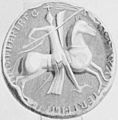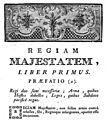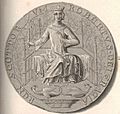Government in medieval Scotland facts for kids
Government in medieval Scotland is all about how the country was run from the time the Romans left in the 400s, through the growth of the kingdom of Alba (which became Scotland), up until the 1400s when new ideas from the Renaissance began to change things.
In the early days, kings were the main leaders. There were many small kingdoms, and kings often fought each other. Their main job was to lead their people in war. Kings also had special ceremonies, like coronations, to show their power. The Kingdom of Alba, formed when the Scots and Picts united, kept these traditions. The coronation ceremony at Scone was very important. Even though Scottish kings often traveled, Scone remained a key place. Later, castles in Stirling and Perth became important royal spots. Eventually, Edinburgh became the capital city in the late 1400s. Over time, the Scottish crown became more respected. It adopted many practices from other European royal courts.
Early Scottish kings relied on powerful lords called mormaers (later known as earls) and Toísechs (later thanes). But when David I became king, he introduced sheriffdoms. These were areas managed by a sheriff, which gave the king more direct control. This slowly reduced the power of the big lords. We don't know much about early Scottish laws. But from the 1100s, royal justice started to grow. Local courts, like sheriff and burgh courts, helped manage justice. The Scots common law began to develop, and people tried to write down and organize the laws. Later, important government groups like the King's Council and Parliament grew stronger. The King's Council became a full-time group in the 1400s. It was mostly made up of ordinary people, not just nobles, and was key to justice. Parliament also became very important. It gained power over taxes and big decisions. It met almost every year, partly because kings were often young and needed others to help rule. This stopped Parliament from being ignored by the king.
Contents
The Role of Kings in Scotland
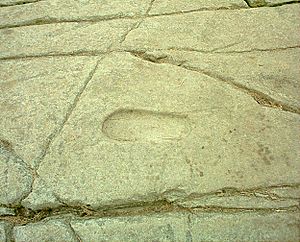
In the early medieval period, Scotland had many small kingdoms. Kingship was not always passed directly from father to son. A person usually had to be from a certain royal family. Kingship could also be complicated and change often. For example, the Pictish kings of Fortriu often ruled over other Pictish kings. Sometimes, they even ruled over non-Pictish kings. But sometimes, they had to accept other powerful rulers, like the Anglians or Britons, as their overlords.
These relationships might mean paying tribute or providing soldiers. If a ruler won a battle, they might give rewards to their loyal supporters. Marrying into the families of smaller kingdoms could also lead to those kingdoms becoming part of a larger one. Over time, kingship became more controlled by a few very powerful families.
The main job of a king was to be a war leader. This is why there were very few young kings or queens ruling alone during this time. Kings protected their people's land, property, and lives. They also made deals with other kings to keep things safe. If they failed, towns might be attacked, destroyed, or taken over. People could be killed or made slaves. Kings also led smaller raids and bigger wars. These wars could involve large armies and alliances, even over long distances.
Kingship also had special traditions. The Scottish kings of Dál Riata had a ceremony where they put their foot in a stone footprint. This showed they would follow in the footsteps of past kings. The Kingdom of Alba, which became Scotland, used Scone and its special stone for coronations. This tradition likely came from the Picts. It was said to go back to when Scottish kings first arrived from Ireland. Before the wars with England, Scottish kings were crowned on the Stone of Scone. This stone was taken by Edward I of England in 1296.
The first detailed coronation ceremony we know about was for Alexander III in 1249. It mixed old traditions, church practices, and noble customs. The Bishop of St Andrews blessed him. The powerful Mormaers of Strathearn and Fife placed him on the throne. A royal poet from the Highlands recited his family history in Gaelic, tracing it back to his Scottish ancestors. Unlike other European kings, he was not anointed with oil or given a crown during the ceremony. Later kings tried to get the Pope to allow this. However, Scottish kings are usually shown wearing crowns and carrying royal symbols.
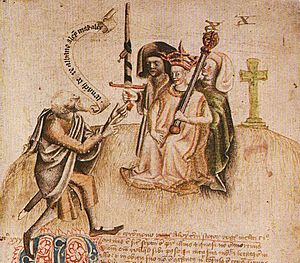
For most of the medieval period, the king traveled a lot and didn't have one main capital city. David I (who ruled from 1124–53) tried to make Roxburgh a royal center. But in the 1100s and 1200s, more official documents were signed at Scone than anywhere else. Other popular places were nearby Perth, Stirling, Dunfermline, and Edinburgh. Later, kings moved between royal castles, especially Perth and Stirling. They also held court sessions all over the kingdom. Edinburgh only really started to become the capital when James III was king, which some people didn't like.
The joining of the kingdom, the spread of Anglo-Norman customs, and the growth of trade helped make the Scottish crown more respected. Robert I's success in gaining independence from England also greatly increased its prestige.
In the 1400s, like many European kings, the Scottish crown looked to the Burgundian court for ideas. They adopted more formal and elegant ways. This made the king's court a center of culture and politics. It involved grand displays, rituals, and ceremonies. New palaces and support for the arts showed this change. Renaissance ideas also started to influence how people thought about government. This was called "New Monarchy." It stressed the importance and power of the king.
The Roman law idea that "a king is emperor in his own kingdom" appeared in Scotland from the mid-1400s. In 1469, Parliament passed a law saying that James III had "full power and rule within his realm." From the 1480s, the king's image on his silver coins showed him wearing a closed, arched imperial crown. This was different from the open crowns of earlier kings. It was probably the first coin image of its kind outside Italy. This new crown soon appeared in royal symbols, on seals, in books, sculptures, and on church steeples, like at St. Giles Cathedral in Edinburgh. The first Scottish king to actually wear such a crown was James V. His crown was changed in 1532 to include arches. It was rebuilt in 1540 and is now the Crown of Scotland. The idea of an imperial monarchy meant the crown was very important. It was seen as a force that united the country, protected its borders, and had power over the law and the national church. New Monarchy also meant the king relied on "new men" (skilled people from ordinary families) instead of just powerful nobles. It also involved using church leaders as government workers and developing permanent armies and a navy.
The King's Council: Royal Advisers
The King's Council was the most important government group after the king himself in the late Middle Ages. It was made up of the king's closest advisers. Unlike England's council, Scotland's King's Council could make laws and act as a court. It was quite small, usually with fewer than 10 members at a meeting. Some members were chosen by Parliament, especially when the king was young. This helped limit the power of the person ruling for the king.
By the late 1400s, the council worked almost full-time. Old records show it was vital for royal justice. While some powerful nobles were officially members, they rarely attended meetings. Most active members were career administrators and lawyers. They were almost always church leaders who had gone to university. The most successful of these often became important church leaders, like bishops or archbishops. By the end of the 1400s, more educated ordinary people, often lawyers, joined this group. The most successful of them gained important jobs in the justice system and were given land and titles. From James III's reign, the top job of Lord Chancellor, which used to be held by church leaders, was increasingly given to leading ordinary people.
Parliament: The Voice of the People
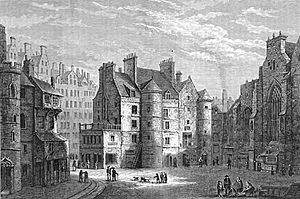
After the King's Council, Parliament was the next most important group in government. It grew from the King's Council of Bishops and Earls in the late 1200s. It became a meeting place with a role in politics and justice. By the early 1300s, knights and landowners also attended. From 1326, representatives from towns (burghs) joined them. These three groups formed the "Three Estates." They met in various towns across the kingdom.
Parliament gained significant power over certain issues, like approving taxes. It also had a strong influence on justice, foreign policy, war, and other laws. Under Robert I, Parliament became even more important. He called them more often, and more towns and smaller landowners were represented. In 1399, a General Council decided that the King should hold a Parliament at least once a year for the next three years. This was to make sure "his subjects are served by the law."
From the early 1450s, much of Parliament's law-making work was done by a special committee. This committee was called the 'Lords of the Articles.' The three estates chose them to write laws. These laws were then presented to the full Parliament to be approved. Before the 1500s, Parliament's work was also done by similar groups. These included the General Council and the Convention of Estates. These groups could deal with taxes, laws, and policies. However, they did not have the full authority of a complete Parliament.
In the 1400s, Parliament was called almost every year. This was more often than its English counterpart. It was also willing to sometimes disagree with or criticize the king's policies. This was especially true during the unpopular reign of James III. However, from about 1494, after James IV had success against rebels, he managed to rule largely without Parliament. It might have become less important, like similar groups in Europe. But then James IV died in 1513, and another long period of a young king needing others to rule saved Parliament's power.
Images for kids
-
The seal of Walter Fitzalan (1106–77), the first hereditary royal stewart
-
The Regiam Majestatem is the oldest surviving written digest of Scots law.
-
An engraving of Robert II shown as a lawgiver on his great seal



